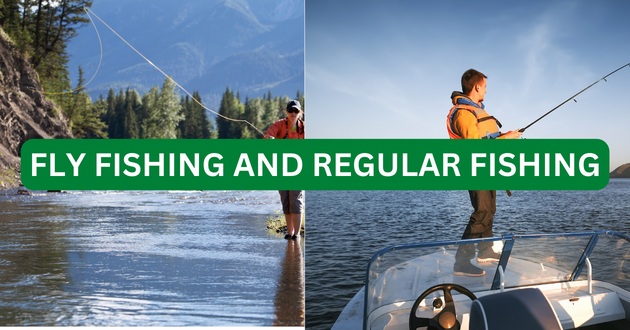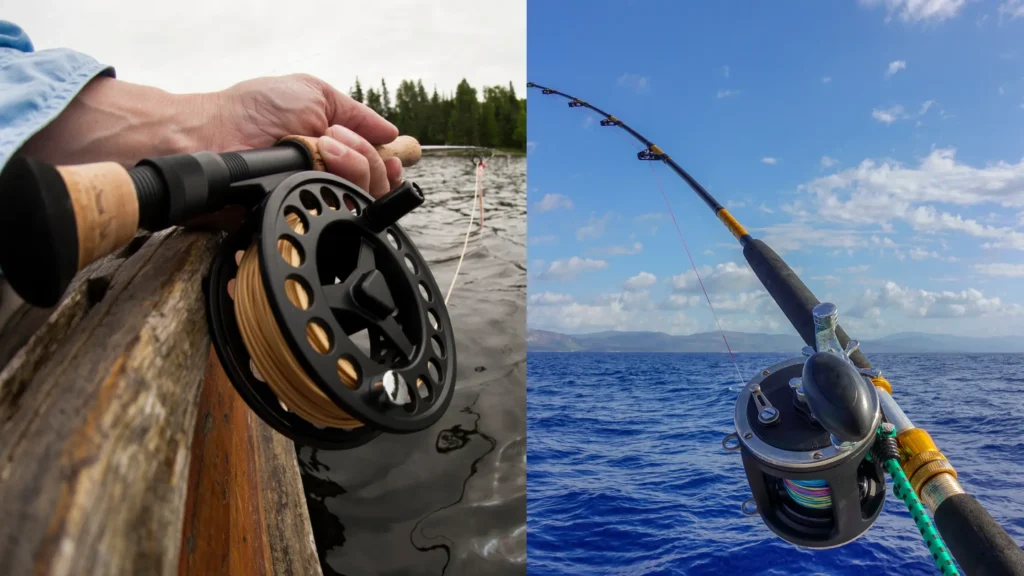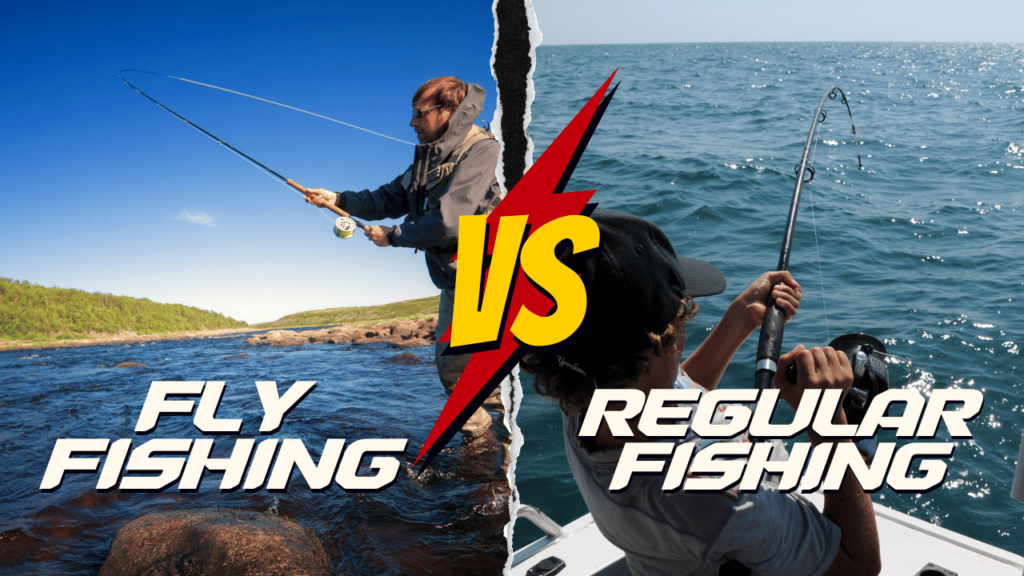Fishing, a timeless activity, has been a favorite pastime for many throughout history. From the thrill of the catch to the serenity of nature, it offers an unparalleled experience.
While the essence of fishing remains consistent, the methods and techniques have evolved over time.
Two of the most popular methods that have captivated enthusiasts are Fly Fishing and Regular Fishing.
But what sets them apart?

In this guide, I’ll dive into what’s the differences between fly fishing and regular fishing – from the gear and techniques used, to the types of fish you can target.
Table of Contents
What is Fly Fishing?
Fly Fishing is a unique and specialized form of fishing that stands out due to its distinct techniques and equipment. Unlike traditional methods, fly fishing involves using lightweight flies to mimic the natural food sources of fish. The art of casting in fly fishing is unlike any other, relying on the weight of the line rather than the lure.
Definition and Basics of Fly Fishing
At its core, fly fishing is about using hand-tied flies that resemble natural invertebrates or other food organisms to lure fish. These flies are cast using a special fly rod and a fly line. The line’s weight allows the angler to send the fly to the desired location.
The Unique Gear Used in Fly Fishing
| Equipment | Purpose |
|---|---|
| Fly rods | Designed to cast lightweight flies. They are flexible and come in various lengths and weights. |
| Fly reels | Store the fly line and provide drag resistance against hooked fish. |
| Fly lines | Weighted lines that allow for the casting of lightweight flies. |
The choice of gear is crucial in fly fishing. The fly rod‘s flexibility, combined with the weight of the fly line, allows for precise casts, especially in challenging conditions like windy environments.
The Art of Casting in Fly Fishing
Casting in fly fishing is a rhythmic process. It’s not just about throwing the line out, but about understanding the momentum and using it to your advantage.
The weight of the line is used to carry the fly to the target, and techniques like “hauling” can increase the distance and accuracy of the cast.
What is Regular Fishing (Spin Fishing)?
Regular Fishing, often referred to as Spin Fishing, is the method most people are introduced to when they first pick up a fishing rod.
It’s versatile, straightforward, and can be used in various fishing scenarios, from freshwater lakes to deep-sea ocean fishing.
Definition and Basics of Regular Fishing
Spin fishing is all about using a weighted lure or bait to attract fish. The weight of the lure or bait allows the angler to cast it out into the water. Once cast, the lure can be retrieved, mimicking the movement of prey, enticing fish to bite.
Gear Used in Regular Fishing
| Equipment | Purpose |
|---|---|
| Spinning rods | Designed for casting and retrieving lures or bait. They are versatile and can handle different fishing situations. |
| Spinning reels | Attached beneath the rod, they store the fishing line and assist in casting and retrieval. |
The spinning rod and reel combo is a staple in the tackle boxes of many anglers. Its versatility makes it suitable for both beginners and seasoned pros.
Casting Techniques in Regular Fishing
In spin fishing, the casting technique is more straightforward than in fly fishing. The weight of the lure or bait propels the cast.
Depending on the situation, anglers might use overhead casts, side casts, or even underhand tosses to present their bait effectively.

Key Differences Between Fly Fishing and Regular Fishing
While both fly fishing and spin fishing aim to catch fish, their approaches, gear, and techniques vary significantly.
Gear and Equipment:
As discussed, fly fishing uses specialized gear like fly rods and fly reels, while spin fishing primarily uses spinning rods and spinning reels. The choice of tackle in each method is also different, with fly fishing using flies and spin fishing using various lures and baits.
Casting Techniques:
Casting in fly fishing relies on the weight of the line, while in spin fishing, it’s the weight of the lure or bait that enables the cast.
Types of Fish Targeted:

Both methods can be used to target a wide range of fish.
| Fly fishing is often associated with targeting specific species of fish such as trout, bass, and salmon. These fish are often found in cold, clear streams and rivers, and are known for their agility and strength. | In contrast, regular fishing can be used to target a wide variety of fish in different environments, including freshwater and saltwater. Some examples of fish that are commonly targeted with regular fishing methods include catfish, panfish (such as bluegill and perch), pike, and various types of saltwater fish like redfish and snapper. |
Advantages of Each Method
Every angler has their preference, and both methods have their merits.
Benefits of Fly Fishing
Fly fishing offers a unique challenge and connection to nature. The use of lightweight flies requires precision and skill, making every catch rewarding.
Additionally, fly fishing is often seen as more environmentally friendly, as it typically uses barbless hooks and promotes catch and release.
Benefits of Regular Fishing
Spin fishing is versatile and can be used in a variety of fishing locations, from calm lakes to turbulent ocean shores.
It’s also generally easier for beginners to pick up, given its straightforward casting technique.

Fly Fishing VS Regular Fishing: Which Method is Right for You?
Choosing between fly fishing and spin fishing boils down to personal preference, the type of fish you’re targeting, and where you’re fishing. Both methods offer unique experiences, and many anglers enjoy mastering both.
If you have patience, love of outdoors, attention to detail, Confidence go for fly fishing.
You may alsi like to know:
- Does Fly Fishing Hurt Fish? (7 Questions Answered!)
- How Long Will It Take To Learn To Fly Fish?
- What months are best for fly fishing?
- Can you fly Fish with a spinning rod?
FAQs about Fly Fishing and Regular Fishing
Can I use a spinning rod to cast flies?
Yes, it’s possible to use a spinning rod to cast flies, especially when using weighted flies or adding split shot to the line. However, it won’t provide the same experience as using a dedicated fly rod. When using a spinning rod for this purpose, it’s often referred to as “fly and bubble” fishing.
Is fly fishing more expensive than regular fishing?
The initial investment for fly fishing gear can be higher than spin fishing equipment. However, the long-term costs can be comparable. Factors like brand, quality, and the specific gear chosen play a significant role in determining the overall expense.
Fly Fishing VS Regular Fishing: Which method is more environmentally friendly?
Both methods can be environmentally friendly when practiced responsibly. Fly fishing often gets a nod for being slightly more eco-friendly due to the use of barbless hooks and the emphasis on catch and release. However, responsible spin fishing, with proper handling of fish and mindful tackle choices, can also minimize environmental impact.
Is fly fishing harder than spin fishing?
Fly fishing has a steeper learning curve due to its unique casting technique and the need to understand fly choices and presentations. Spin fishing is generally more accessible for beginners. However, with practice and dedication, many find fly fishing to be a rewarding challenge.
What types of fish are commonly targeted in fly fishing?
While trout and salmon are classic targets for fly anglers, a variety of species can be pursued, including bass, pike, and even saltwater species like tarpon and bonefish.
How do tides and currents affect fishing?
Tides and currents play a crucial role, especially in saltwater fishing. They influence fish movements, feeding patterns, and can determine the accessibility of certain fishing locations. Understanding and timing your fishing activities around these factors can significantly improve success rates.
Bottom Line
Fly Fishing and regular fishing may seem similar at first glance, but they actually have many differences. Fly fishing uses artificial flies and specialized equipment, while regular fishing typically involves live bait and more traditional rods and reels.
Fy fishing is often done in smaller, more challenging bodies of water, whereas regular fishing can be done in a variety of locations. Whether you prefer fly fishing or regular fishing, both offer unique experiences and the opportunity to enjoy the great outdoors.
